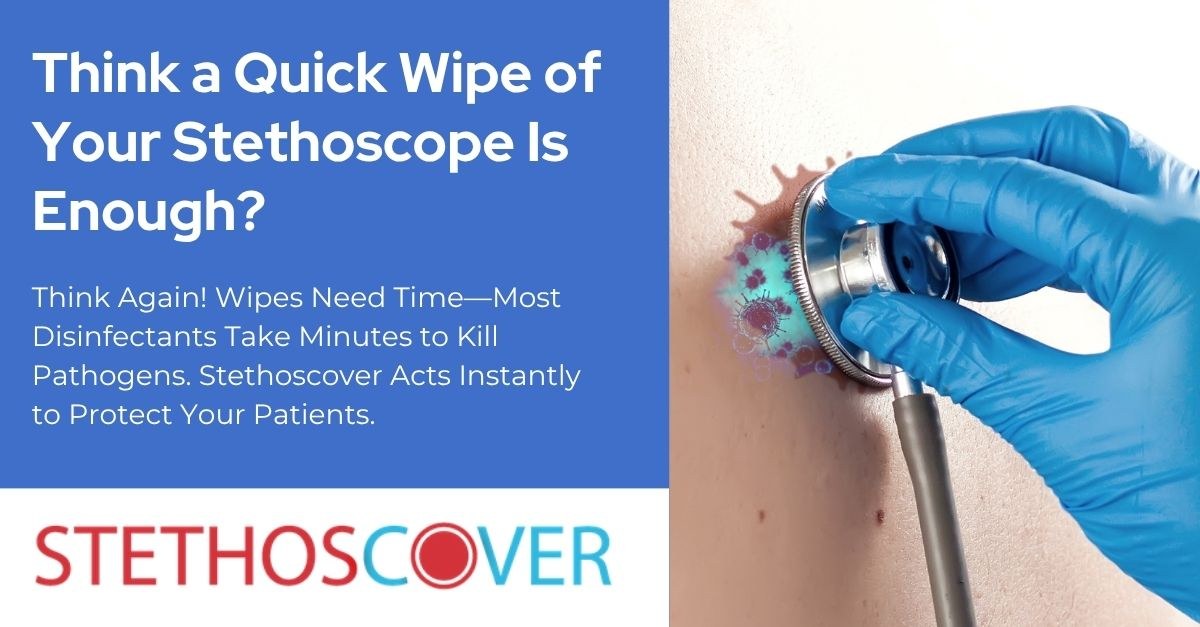When it comes to infection control, most clinicians know the importance of using effective disinfectants. But there's one detail that’s often overlooked—contact time. This is the amount of time a disinfectant must remain wet on a surface to effectively kill pathogens. If the surface dries too quickly (as is often the case with quick wipes), the disinfectant may not have enough time to do its job.
This issue becomes especially important with non-porous medical tools like stethoscopes, which are used frequently, travel between patients, and are often wiped hastily between uses. Without the correct contact time, dangerous pathogens may remain, putting both patients and providers at risk.
At Stethoscover, we’re passionate about improving infection prevention—efficiently. That’s why we’re sharing this simplified guide to help you better understand the limitations of disinfection and why a disposable barrier like Stethoscover can help close the gap.
Top 3 HAI Pathogens You Should Be Targeting
-
Clostridioides difficile (C. diff) – A spore-forming bacterium that’s highly resistant and difficult to kill
-
Methicillin-resistant Staphylococcus aureus (MRSA) – A gram-positive bacteria resistant to multiple antibiotics
-
Pseudomonas aeruginosa – A gram-negative pathogen that’s both antibiotic and disinfectant resistant
Disinfectant Contact Time Cheat Sheet (Most Common Products)
70% Isopropyl Alcohol
-
MRSA: 30 seconds to 1 minute
-
Pseudomonas: 30 seconds to 1 minute
-
C. diff (Spores): ❌ Not effective
0.5% Sodium Hypochlorite (Bleach)
-
MRSA: 1 minute
-
Pseudomonas: 1 minute
-
C. diff (Spores): 4 to 10 minutes
Quaternary Ammonium Compounds (Quats)
-
MRSA: 1 to 3 minutes
-
Pseudomonas: 1 to 3 minutes
-
C. diff (Spores): ❌ Not effective
What This Means for Stethoscope Hygiene
Most clinicians aren’t letting disinfectants sit on their stethoscope diaphragms for 1–10 minutes between patients. Surfaces dry quickly, and in fast-paced clinical environments, it’s nearly impossible to maintain proper contact time consistently—especially when dealing with hard-to-kill pathogens like C. diff.
This is exactly why Stethoscover was created: to provide a reliable disposable barrier that protects patients with each use, without relying solely on rushed or inconsistent disinfection practices. By covering the stethoscope diaphragm, you reduce the risk of pathogen transfer—even when contact times fall short.
The Bottom Line
Disinfectant choice matters, but so does time. In the fight against HAIs, relying solely on wipes may not be enough. Know your contact times—and take the extra step with Stethoscover to protect your patients more effectively.
References:
-
CDC Guidelines for Disinfection and Sterilization in Healthcare Facilities
-
EPA List K: Antimicrobial Products Effective Against C. diff Spores
-
Manufacturer data (Clorox Healthcare, Oxivir, CaviWipes)

